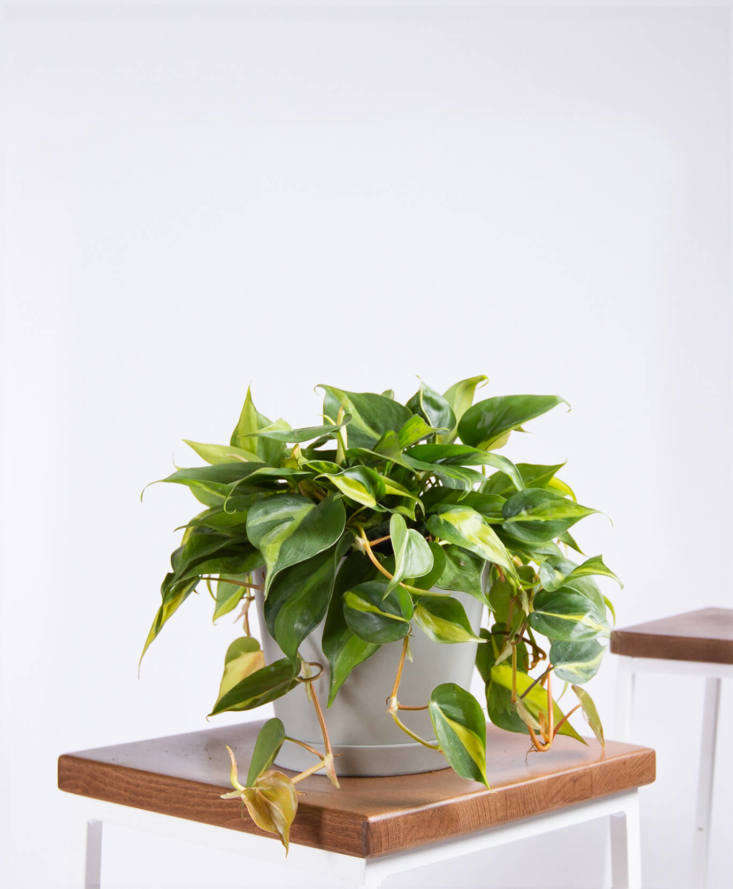Philodendron: “Choose Your Own Adventure”
Philodendron is a genus that offers something for everyone. If you’re looking for an easy-to-care-for houseplant, chances are one of its nearly 500 species will suit. With a name that comes from the Greek, a combination of “love” (philo) and “tree” (dendron), Philodendron is a good-natured and leafy addition to a home.
Power user’s tip: Split Leaf Philodendron, sometimes called Lacy Tree Philodendron, is commonly confused with Monstera. An easy way to tell the two apart? Monstera leaves are often punctuated with oblong holes, while the leaves of a Split Leaf Philodendron don’t have holes.

The two main types of philodendron are vines and non-climbers. A Philodendron Brasil (shown Above) adds a leafy backdrop to a bedroom. “Many plants can be trained as a vine to grow along a wall or around a window,” says Tassy de Give, owner of the Brooklyn plant shop Sprout Home. “If you want a good, low-maintenance hanging plant, philodendrons are one of the easiest vines that provide length and ease of care.”
Philodendron, native to the Americas and the West Indies, thrives in moist soil where their partyl-aerial roots like to climb. Some species of Philodendron can have very large leaves and produce berries.

Beyond its modern appeal as a houseplant, Philodendron has a long history of clever usage: In South America, the resin from flowering Philodendron has been used to make guns airtight; the leaves have been made into poultices for fevers and sores, and the toxins produced by Philodendron Craspedrodrum have been used in fishing (the poison stuns the fish and brings them to the surface of the water). The aerial roots can also be used to make a sturdy rope.

Cheat Sheet
- If you’re growing a vining Philodendron, give it something, like a trellis or post, on which to grow.
- Plant a larger Philodendron in a pot on the floor or a sill—or grow smaller varieties, such as Heart Leaf, in a basket and hang from a ceiling or beam.
- Use a damp cloth to clean Philodendron leaves of dust and bugs and to maintain the plant’s shine.

Keep It Alive
- Set a potted Philodendron near a sunny window, but make sure the rays don’t shine directly on the leaves. Watch your plant for signs: If several leaves turn yellow, the plant is getting too much sun; if the stems grow long with large gaps between the leaves, the plant needs more light.
- Allow the top inch of soil to dry out completely before watering the plant.
- Even indoor Philodendrons appreciate a jaunt outdoors every once in a while. Set the pot outside in a fairly shady spot for some fresh air.
Philodendron are adaptable and easy to care for. “They take very well to pruning and are very easy to propagate,” says Susanne Kongoy, owner of New York-based garden shop GRDN. “They are great plants for bookshelves as they cascade down.”
For more striking but easy-to-care-for houseplants, see our Gardening 101 posts on Aralia, Totem Pole Cactus, and Sansevieria.
Finally, get more ideas on how to successfully plant, grow, and care for philodendron with our Philodendron: A Field Guide.
Interested in other tropical plants for your garden or indoor space? Get more ideas on how to plant, grow, and care for various tropical plants with our Tropical Plants: A Field Guide.
Finally, get more ideas on how to plant, grow, and care for various vines and climbers with our Vines & Climbers: A Field Guide.










Have a Question or Comment About This Post?
Join the conversation